
All Solutions
Section 3-2: Characteristics of Polynomial Functions
$$
color{#4257b2}text{(a)} f(x)=-4x^4+3x^2-15x+5
$$
Degree is equal $4$ [Higher degree]
Leading coefficient is equal $-4$
Degree is even number, so the the end behavior is the same.
$$
color{#4257b2}text{(b)} g(x)=2x^5-4x^3+10x^2-13x+8
$$
Degree is equal $5$ [Higher degree]
Leading coefficient is equal $2$
Degree is odd number, so the the end behavior is opposite.
$$
color{#4257b2}text{(c)} p(x)=4-5x+4x^2-3x^3
$$
Degree is equal $3$ [Higher degree]
Leading coefficient is equal $-3$
Degree is odd number, so the the end behavior is opposite.
color{#4257b2}text{(d)} h(x)=2x(x-5)(3x+2)(4x-3)
$$
Use distributive property as follows:
$$
(2x^2-10x)(12x^2-9x+8x-6)
$$
$$
24x^4-18x^3+16x^3-12x^2-120x^3+90x^2-80x^2+60x
$$
Add similar tiles to group like terms as follows:
$$
24x^4+(-18x^3+16x^3-120x^3)+(-12x^2+90x^2-80x^2)+60x
$$
$$
24x^4-122x^3-2×62+60x
$$
Degree is equal $4$ [Higher degree]
Leading coefficient is equal $24$
Degree is even number, so the the end behavior is the same
(b) Degree$=5$ Leading coefficient $=2$ End behavior is opposite
(c) Degree$=3$ Leading coefficient $=-3$ End behavior is opposite
(d) Degree$=4$ Leading coefficient $=24$ End behavior the same
$$
color{#4257b2}text{(a)} f(x)=-4x^4+3x^2-15x+5
$$
Degree is even number equal $4$, so:
Turn point may have $[3, 1]$
Number of zeros may have $[0, 1, 2, 3, 4]$
$$
color{#4257b2}text{(b)} g(x)=2x^5-4x^3+10x^2-13x+8
$$
Degree is even number equal $5$, so:
Turn point may have $[4, 2, 0]$
Number of zeros may have $[1, 2, 3, 4, 5]$
$$
color{#4257b2}text{(c)} p(x)=4-5x+4x^2-3x^3
$$
Degree is even number equal $3$, so:
Turn point may have $[2, 0]$
Number of zeros may have $[1, 2, 3]$
$$
color{#4257b2}text{(d)} h(x)=24x^4-122x^3-2×62+60x
$$
Degree is even number equal $4$, so:
Turn point may have $[3, 1]$
Number of zeros may have $[0, 1, 2, 3, 4]$
text{color{Brown}(a) Turn point may have $[3, 1]$ Number of zeros may have $[0, 1, 2, 3, 4]$
\ \
(b) Turn point may have $[4, 2, 0]$ Number of zeros may have $[1, 2, 3, 4, 5]$
\ \
(c) Turn point may have $[2, 0]$ Number of zeros may have $[1, 2, 3]$
\ \
(d) Turn point may have $[3, 1]$ Number of zeros may have $[0, 1, 2, 3, 4]$}
$$
$$
color{#4257b2}text{(a) The function has an even or odd degree. }
$$
(I) Degree number is even $4$ (II) Degree number is even $6$
(III) Degree number is odd $5$ (IV) Degree number is even $2$
(V) Degree number is odd $3$ (IV) Degree number is odd $3$
$$
color{#4257b2}text{(b) The leading coefficient is positive or negative.}
$$
(I) Leading coefficient is negative (II) Leading coefficient is negative
(III) Leading coefficient is negative (IV) Leading coefficient is positive
(V) Leading coefficient is negative (IV) Leading coefficient is positive
color{#4257b2}(a)
$$
(I) Degree number is even $4$ (II) Degree number is even $6$
(III) Degree number is odd $5$ (IV) Degree number is even $2$
(V) Degree number is odd $3$ (IV) Degree number is odd $3$
$$
color{#4257b2}text{(b)}
$$
(I) Leading coefficient is negative (II) Leading coefficient is negative
(III) Leading coefficient is negative (IV) Leading coefficient is positive
(V) Leading coefficient is negative (IV) Leading coefficient is positive
$$
color{#4257b2}text{(a)} f(x)=2x^2-3x+5
$$
Degree of the function is even $2$, so the end behavior is the same
$$
color{#4257b2}text{(b)} f(x)=-3x^3+2x^2+5x+1
$$
Degree of the function is odd $3$, so the end behavior is opposite
$$
color{#4257b2}text{(c)} f(x)=5x^3-2x^2-2x+6
$$
Degree of the function is odd $3$, so the end behavior is opposite
$$
color{#4257b2}text{(d)} f(x)=-2x^4+5x^3-2x^2+3x-1
$$
Degree of the function is even $4$, so the end behavior is the same
$$
color{#4257b2}text{(e)} f(x)=0.5x^4+2x^2-6
$$
Degree of the function is even $4$, so the end behavior is the same
$$
color{#4257b2}text{(f)} f(x)=-3x^5+2x^3-4x
$$
Degree of the function is odd $5$, so the end behavior is opposite
text{color{Brown}(a) Degree of the function is even $2$, so the end behavior is the same
\ \
(b) Degree of the function is odd $3$, so the end behavior is opposite
\ \
(c) Degree of the function is odd $3$, so the end behavior is opposite
\ \
(d) Degree of the function is even $4$, so the end behavior is the same
\ \
(e) Degree of the function is even $4$, so the end behavior is the same
\ \
(f) Degree of the function is odd $5$, so the end behavior is opposite}
$$
$$
color{#4257b2}text{(a)} y=2x^3-4x^2+3x+2
$$
Figure (B)
$$
color{#4257b2}text{(b)} y=x^4-x^3-4x^2-5x
$$
Figure (A)
$$
color{#4257b2}text{(a)} y=-4x^4+3x^2+4
$$
Figure (E)
$$
color{#4257b2}text{(a)} y=-2x^5+3x^4+6x^3-10×62+2x+5
$$
Figure (C)
$$
color{#4257b2}text{(a)} y=x^2+3x-5
$$
Figure (F)
$$
color{#4257b2}text{(a)} y=3x^3+5x^2-3x+1
$$
Figure (D)
text{color{Brown}$text{(a) Figure (B)}$ $text{(b) Figure (A)}$
\ \
$text{(c) Figure (E)}$ $text{(d) Figure (C)}$
\ \
$text{(e) Figure (F)}$ $text{(f) Figure (D)}$}
$$
$$
color{#4257b2}text{(a) As} (xrightarrow-infty, yrightarrow-infty) text{and as }(xrightarrowinfty, yrightarrowinfty)
$$
The leading coefficient has a positive value as follows:
$$
3x^3+5x^2-3x+1
$$
$$
color{#4257b2}text{(b) As} (xrightarrowpminfty) text{and as }(yrightarrowinfty)
$$
The leading coefficient has a positive value as follows:
$$
x^2+3x-5
$$
$$
color{#4257b2}text{(c) As} (xrightarrowpminfty) text{and as }(yrightarrow-infty)
$$
The leading coefficient has a negative value as follows:
$$
-3x^3+4x^2-5x+4
$$
$$
color{#4257b2}text{(d) As} (xrightarrow-infty, yrightarrowinfty) text{and as }(xrightarrowinfty, yrightarrow-infty)
$$
The leading coefficient has a negative value
$$
-x^2
$$
text{color{Brown}(a) $3x^3+5x^2-3x+1$ (b) $x^2+3x-5$
\ \
(c) $-3x^3+4x^2-5x+4$ (d) $-x^2$}
$$
$$
text{color{#4257b2}[a] $(4)$ Degree, positive leading coefficient, $(3)$ zeros, $(3)$ turning points.}
$$
$$
f(x)=(x-1)^2(x+1)(x+3)
$$

text{color{#4257b2}[b] $(4)$ Degree, negative leading coefficient, $(2)$ zeros, $(1)$ turning points.}
$$
$$
f(x)=-(x^2-1)(x^2+1)
$$
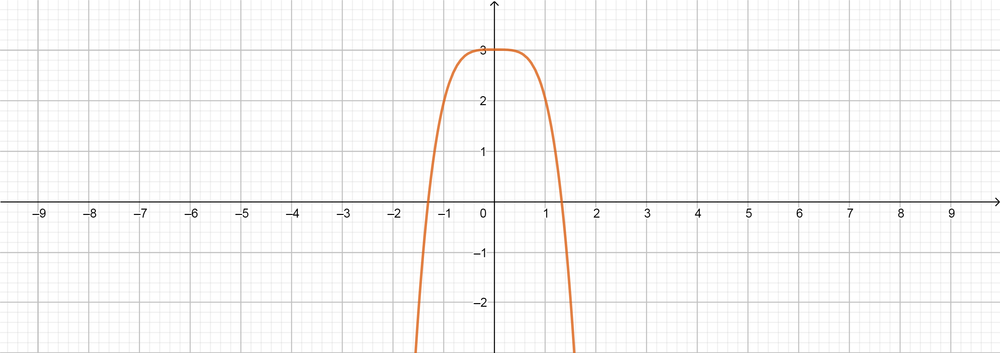
text{color{#4257b2}[c] $(4)$ Degree, positive leading coefficient, $(1)$ zeros, $(3)$ turning points.}
$$
$$
f(x)=-dfrac{1}{2} x^4-dfrac{7}{2} x^3-7x^2-2x-dfrac{15}{100}
$$
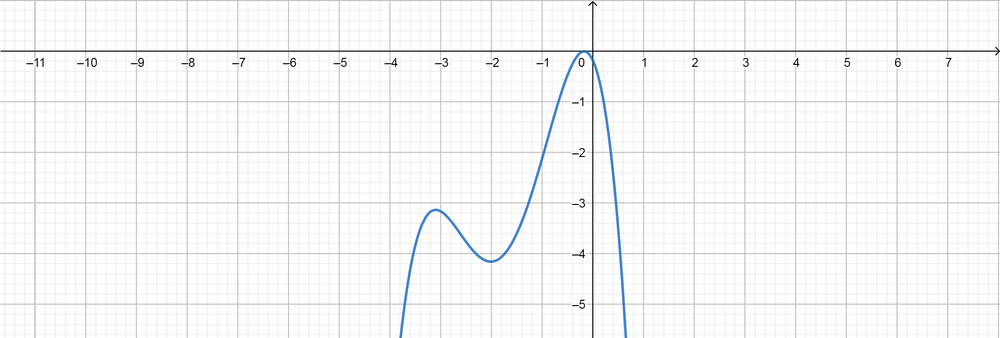
text{color{#4257b2}[d] $(3)$ Degree, negative leading coefficient, $(1)$ zeros, no turning points.}
$$
$$
f(x)=-(x-2)^3
$$
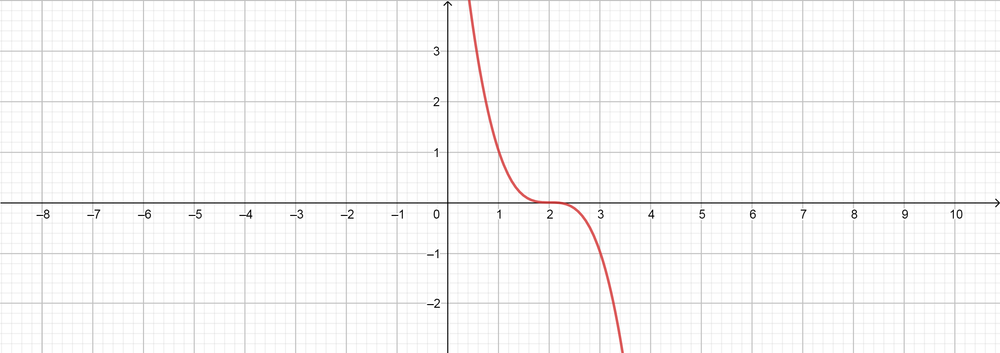
text{color{#4257b2}[e] $(3)$ Degree, positive leading coefficient, $(2)$ zeros, $(2)$ turning points.}
$$
$$
f(x)=x(x-2)^2
$$
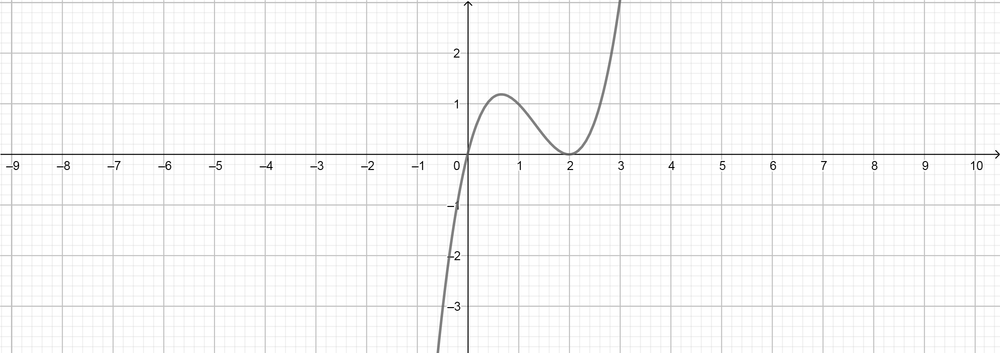
text{color{#4257b2}[f] $(4)$ Degree, positive leading coefficient, $(2)$ zeros, $(3)$ turning points.}
$$
$$
f(x)=(x-1)^2(x+1)^2
$$
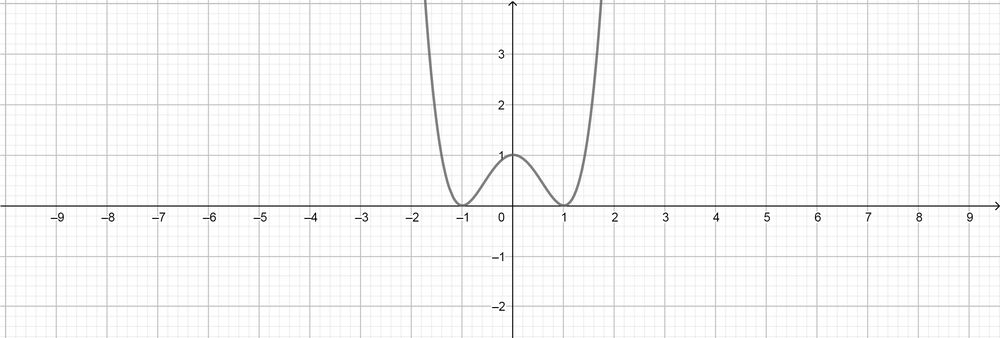
text{color{Brown}See graphs}
$$
$lozenge$ For even functional:
This is confirmed by the end behaviors because they are the same.
$lozenge$ For odd functional:
The end behaviors are opposite, so they have local minimums and maximums.
text{color{Brown}For even functional: This is confirmed by the end behaviors because they are the same.
\ \ \
For odd functional: The end behaviors are opposite, so they have a local minimums and maximums}
$$
text{color{#4257b2}The graph of the function of $f(x)=ax^b-cx$ is symmetrical with respect to the origin and that it has some turning points. That the graph has an odd or even turning points}
$$
$because$ The graph is symmetric with origin $therefore f(-x)=-f(x)$
$$
f(-x)=-ax^b+cx -f(x)=-ax^b+cx
$$
The function of the graph is an odd function, so the turning points for odd function should be an even number.
The graph of function of $f(x)=ax^b-cx$ has an even turning points.
text{color{Brown}The graph of function of $f(x)=ax^b-cx$ has an even turning points}
$$
{$text{color{#4257b2}(a) Only one point intersect with $x$ axis
\
$$x^3+8$$}$
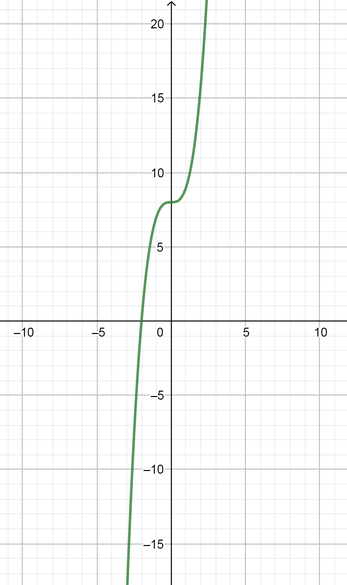
\
$$x^3-4x^2$$}$
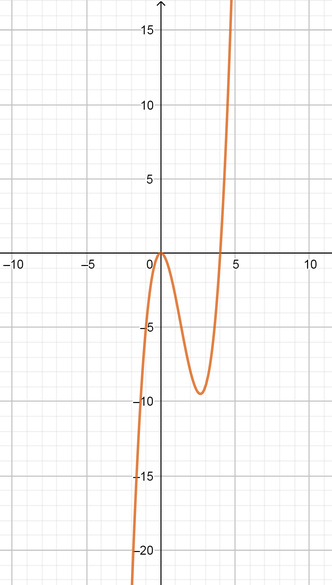
\
$$x^3+2x^2-5x-6$$}$
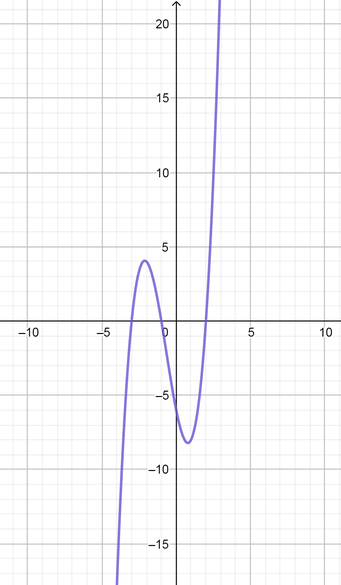
text{color{Brown}See sketches}
$$
{$text{color{#4257b2}(a) No point intersect with $x$ axis
\
$$3x^4-4x^3-4x^2+5x+5$$}$
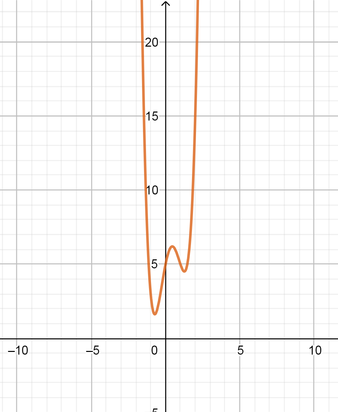
{$text{color{#4257b2}(b) Tow points intersect with $x$ axis
\
$$x^4-5$$}$
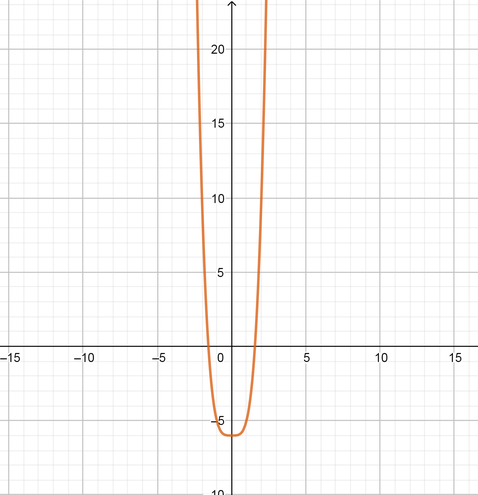
{$text{color{#4257b2}(c) Three points intersect with $x$ axis
\
$$2x^4+8x^3+6x^2$$}$
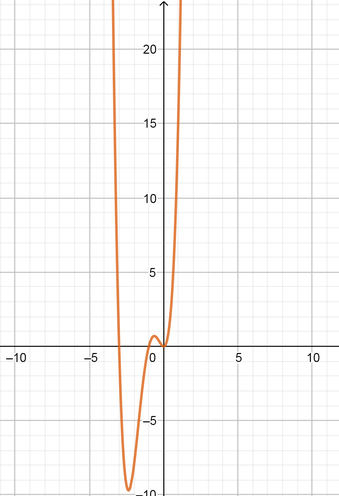
{$text{color{#4257b2}(d) Four points intersect with $x$ axis
\
$$-x^4-2x^3+x^2+2x$$}$
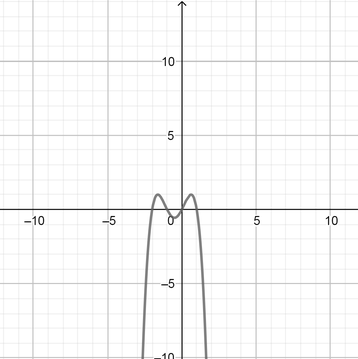
\
$$x^4$$}$

text{color{Brown}See sketches}
$$
$$
f(x)=ax^4+bx^3+cx^2+dc+e$$
$$
begin{align*}
(x-(-2))(x-0)(x-3)&=0&&text{[Simplify]}\
(x+2)x(x-3)&=0&&text{[Multiply]}\
x^3-x^2-6x&=0
end{align*}$$
Now raising the power of each term by $1$ and dividing the each termby the power of $x$, we obtain
$$
dfrac{x^4}{4}-dfrac{x^3}{3}-6dfrac{x^2}{2}=f(x).
$$
Hence,
$$
f(x)=dfrac{1}{4}x^4-dfrac{1}{3}x^3-3x^2.tag{1}
$$
and this function has the turning points $x=-2$, $x=0$, $x=3$.
The same turning points will have a function with any added constant term to $(1)$, such as
$$
begin{align*}
f(x)&=dfrac{1}{4}x^4-dfrac{1}{3}x^3-3x^2+5\
f(x)&=dfrac{1}{4}x^4-dfrac{1}{3}x^3-3x^2-2.
end{align*}$$
The same turning points will have a function if we multiply each term of function $(1)$ by the same number and add any constant term, such as
$$
begin{align*}
f(x)&=x^4-dfrac{4}{3}x^3-12x^2+1&&text{[Multiplied by $4$]}\
f(x)&=dfrac{3}{4}x^4-x^3-9x^2-2.&&text{[Multiplied by $3$]}\
end{align*}$$
The same turning points will have a function if we divide each term of function $(1)$ by the same number and add any constant term, such as
$$
begin{align*}
f(x)&=dfrac{1}{8}x^4-dfrac{1}{6}x^3-dfrac{3}{2}x^2+2&&text{[Divided by $2$]}\
f(x)&=dfrac{1}{12}x^4-dfrac{1}{9}x^3-x^2-1.&&text{[Divided by $3$]}
end{align*}$$
We will choose
$$
y=x^4-dfrac{4}{3}x^3-12x^2+1 text{and} y=dfrac{1}{12}x^4-dfrac{1}{9}x^3-x^2-1
$$
Graph the two functions in *Figure 1*.

*Figure 1.* The graph of the two functions
Note that the population expressed by $y=-0.1x^4+0.5x^3+0.4x^2+10x+7$
Population since $1900$, that mean $x=0$
$$
y=-0.1(0)^4+0.5(0)^3+0.4(0)^2+10(0)+7
$$
$$
y=0+7 y=7
$$
The population is $y=7$ in hundred
(b) Describe what happen of the population over time.
Note that, if the number of year since $1900$ is increase, the population in hundred is increase too.
text{color{Brown}(a) $y=7$ in hundred.
\ \
(b) The population in hundred is increase.}
$$
(a) $f$ Is an even function $text{color{#4257b2}True}$
(b) $f$ Can not be an odd function $text{color{#4257b2}True}$
(c) $f$ Will have at least one zero $text{color{#4257b2}False}$
(d) $f$ As $xrightarrowpminfty$ and $yrightarrowinfty$ $text{color{#4257b2}True}$
text{color{Brown}(a) True (b) True (c) False (d) True}
$$
(I) What is the degree of the equation?
To predict the bumper of turn point and number of zeros.
(II) What is the sign of the leading coefficient?
To predict the function upward or downward.
(III) What is the end behavior of the equation?
To predict the extension of the equation.
text{color{Brown}(I) What is the degree of the equation?
\ \
(II) What is the sign of the leading coefficient?
\ \
(III) What is the end behavior of the equation?}
$$
$$
color{#4257b2}y=ax^2+bx+c
$$
This function may have no zeros
This function may have a turning point $n-1$
This function have the same end behavior
(b) What must be true about the function if an odd function?
$$
color{#4257b2}y=ax^3+bx^2+cx+d
$$
This function must have at least one zeros
This function may have a turning point $n-1$
This function have the opposite end behavior
text{color{Brown}(a) This function may have no zeros
\ \
This function may have a turning point $n-1$
\ \
This function has the same end behavior.
\ \
(b) This function must have at least one zeros
\ \
This function may have a turning point $n-1$
\ \
This function has the opposite end behavior.}
$$

